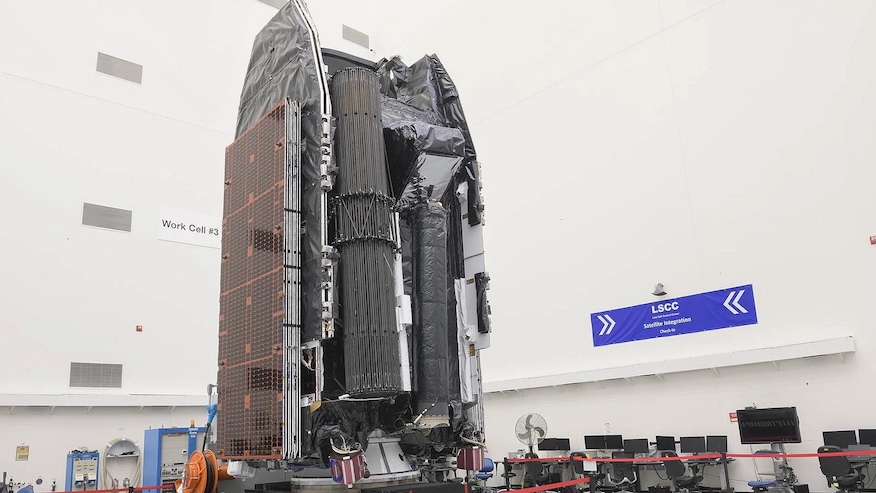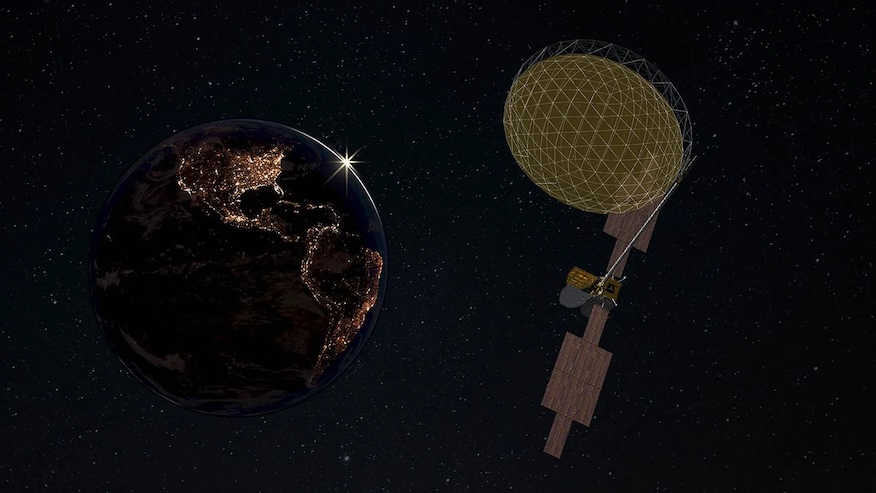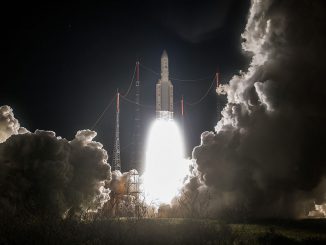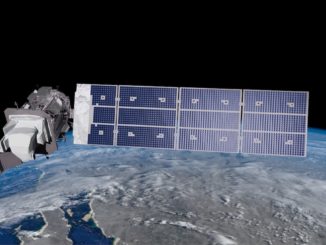
The ViaSat-3 Flight 2 spacecraft, the next geostationary satellite for communications company Viasat, arrived in Florida in the early morning hours of Tuesday.
This six-ton (more than 13,000 lbs) satellite is the second in a three-vehicle series for the ViaSat-3 network. Its planned launch in late October onboard a United Launch Alliance Atlas 5 551 rocket comes roughly a year-and-a-half after the ViaSat-3 F1 launch.
“ViaSat‑3 F2 is the next important step in our roadmap to meet the increasing demand for resilient, global satellite communications from commercial mobility and defense customers,” said David Abrahamian, vice president of Space Systems at Viasat. “Completion and delivery of the satellite to the launch site is a big milestone in our partnership with Boeing and is the direct result of years of collaboration between the Boeing and Viasat teams.”
Viasat said this second Ka-band satellite will more than double the bandwidth capacity of its current satellite fleet, adding more than 1 terabit-per-second (Tbps) of capacity over both North and South America.
High capacity. Highly flexible. One step closer to launch! 🛰️🚀
ViaSat-3 F2 has completed its flight from @flyLAXairport to @NASAKennedy on board an Antonov! Discover what’s next as we prepare for launch late Oct 2025 with @ULALaunch. https://t.co/Yqp3bjmbpV#VS3F2 #AtlasV pic.twitter.com/90zB3ibU91
— Viasat (@viasat) September 30, 2025
The satellite was delivered to Los Angeles International Airport (LAX) by Boeing from its El Segundo, California, facility in a special shipping container. That was then carefully loaded onto a Antonov AN-124 aircraft before taking off from LAX on Monday.
“A huge thank you to everyone who has contributed to this milestone,” Abrahamian said. “Now we turn our focus to getting F2 into orbit, where its tailored capabilities are expected to enable us to better serve our customers and meet increasing demand for resilient, global satellite communications.”
The satellite operates on Boeing’s 702MP+ platform with more than 25 kW of power generated by Boeing subsidiary Spectrolab’s solar arrays. These satellites are designed to offer connectivity for commercial aviation and maritime customers as well as offering government and defense applications.
“Our goal is to enable missions with reliability and timely delivery,” said Michelle Parker, vice president of Boeing Space Mission Systems. “With ViaSat‑3 F2, we leveraged proven 702 heritage, advanced power systems and all‑electric propulsion to enable high-speed connectivity for users who rely on it.”
Following launch, it will go through its orbit raising maneuvers and is expected to enter service in early 2026.

Learning from the past
The ViaSat-3 F1 satellite launched on April 30, 2023, on a SpaceX Falcon Heavy rocket from NASA’s Kennedy Space Center and entered into commercial service on Aug. 5, 2024.
Viasat announced the start of service for government customers in an October 2024 press release. It stated that the satellite was being used by the Marine Wing Communications Squadron 38 (MWCS-38) and the 3rd Marine Littoral Regiment within the U.S. Marine Corps.
“This is an important milestone for our government services and solutions team and U.S. Department of Defense and global government customers,” said Susan Miller, President of Viasat Government at the time. “The ViaSat-3 satellite network was designed with government missions in mind, offering greater capacity and the flexibility to dynamically shift bandwidth where it’s needed most. The use of small beams, beam shaping, encryption and ViaSat-3’s unique anti-jam capabilities are designed to provide secure and reliable connectivity to support the most critical government missions.”

The start of service for ViaSat-3 F1 was delayed due to an issued with deploying the antenna. Viasat said in subsequent statements that “all other systems on the satellite were operating at or beyond expectations.”
“This deployment anomaly resulted in a significant reduction in overall capacity, but the resiliency and high-performance specifications of the satellite still allow it to support high-speed broadband services for government and commercial customers over North America, where the satellite is currently deployed,” Viasat said in October 2024.
In Viasat’s earnings report announced Nov. 8, 2023, Viasat CEO Mark Dankberg said the anomaly reduced the throughput on the ViaSat-3 F1 satellite by more than 90 percent.
According to a prelaunch interview with CBS News’ William Harwood in 2023, David Ryan, Viasat’s president of space and commercial networks, indicated that the satellite’s antenna was manufactured by Astro Aerospace, a subsidiary of Northrop Grumman.
The impacts from this issue and a separate anomaly on the Inmarsat-6 F2 satellite had sizable financial impacts for the company.
“As a result of the anomalies that occurred with respect to the ViaSat-3 F1 and I-6 F2 satellites in fiscal year 2024, the Company recorded a reduction to the carrying value of the satellites of approximately $1.67 billion in fiscal year 2024, which was partially offset by total insurance claim receivables of approximately $770.0 million, and for which the final payment was received in the first quarter of fiscal year 2026,” Viasat wrote in a filing to the U.S. Securities and Exchange Commission dated Aug. 7, 2025.
Looking to the future
Following the launch of the ViaSat-3 F2 satellite and its planned introduction to service in early 2026, ViaSat plans to launch the third satellite in the series later in 2026.
The ViaSat-3 F3 spacecraft reportedly has a different antenna design that is being provided by L3Harris Technologies, according to Space News. At this point though, it’s unclear how Viasat is planning to get it to space.
This spacecraft, which will serve the Asia-Pacific region, was originally scheduled to launch on an Ariane 6 rocket, but due to delays with that rocket’s debut Viasat decided to put out another bid for launch proposals.
To date, Viasat has not publicly announced which rocket will carry its ViaSat-3 F3 satellite.



